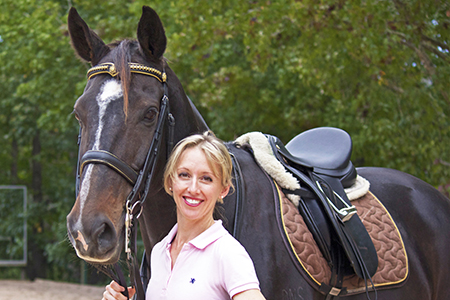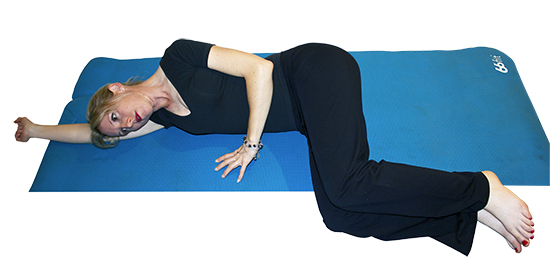 In part three, Rebecca Ashton introduces the exercise, Clams. This is a common exercise in pilates classes; here Rebecca explains how it will help your riding. This exercise allows you to use your legs individually and precisely; creating clearer communication with the horse.
In part three, Rebecca Ashton introduces the exercise, Clams. This is a common exercise in pilates classes; here Rebecca explains how it will help your riding. This exercise allows you to use your legs individually and precisely; creating clearer communication with the horse.
Now that we have brought awareness to our core, this month we are going to look at leg stability.
On the horse your legs should be stretching down to help anchor the pelvis. They should rest against the horseís side like wet towels, breathing with the horse and ready to give a stronger aid if need be. Good control of the leg creates clearer communication with the horse. You need to be able to apply the appropriate leg pressure whenever you want. The thigh should be snug against the saddle but not restrictive, with the knees and toes pointing forward. Too strong a leg and the riderís hips, knees and ankles become locked leading to possible tightness or even injury with the shock-absorbing ability of the joints reduced. Also, the horse can become tense and his breathing restricted. In this position, there is no leeway to give a clear aid as the legs are already pressed hard against the horseís side. Too loose a leg and the rider will lose stability in the pelvis. Constant, involuntary leg aids will cause the horse to become dead to the leg and eventually ignore it altogether. The leg will also lose effectiveness as it becomes sloppy, the heel is lifted up and no positive tension remains. In this state, there will be no inside leg for the horse to bend around on a circle and no outside leg to guard against swinging hindquarters.
The Clams exercise will help you find the gluteus medius muscle at the side of the bottom, which will help you lift your legs off the horse. It will also improve your ability to give light, precise leg aids as you will gain better control of your leg. When the exercise is executed slowly and with purpose, the muscles will gain the ability to control and support the hip joint, no matter what leg aids you are giving. It helps teach disassociation between the torso and legs so that your body remains still and keeps you from unbalancing the horse while you give leg aids. Many people give leg aids from the knee when really the leg should be activated from the hip. You will get a better feel for this as a result of Clams.
 The Set Up:
The Set Up:
– Find neutral spine*, lying on your side. Have your shoulder and hip in line. Make sure you maintain a gap under your waist closest to the ground to maintain a neutral pelvis. Knees are bent at 90 degrees, the feet are touching, and the top hip is the highest point.
– Switch off your outer muscles, relaxing your hamstrings and calves.
– On an in breath, using the lateral breathing* method, switch on your core* by imagining the low abs melting inwards towards your spine and lifting up gently through the pelvic floor. When breathing, imagine filling up your lungs completely, including the sides and back, not just the front. The shoulders remain relaxed and still.
Instruction Of Move:
– Breathe out and hinge the top knee up to hip height, keeping feet touching breathe in and lower knee back to start position.
– Do 10 repetitions each side, being careful to maintain your technique and neutral position.
Watch Out For:
– Feet pushing too hard against each other
– Losing gap under lower waist
– Shoulders hunching
– Rolling pelvis back instead of using the glutes to move the leg
– Losing length through the body
– Using quads (muscles at the front of the thigh) instead of glutes
Visualisations:
– Wine glass balancing on your top hip to keep it still and not rocking backwards and forwards
– Legs feel light
– Isolation of glute medius
– Little bird sitting under your lower waist and you donít want to squash it
– Extending the top knee forward slightly before you move it to help keep the top hip
from rocking back.
 On the horse:
On the horse:
You can test out the results of this exercise by riding up the centre line with your legs off the horse. See how long you can keep your legs lifted. Take note whether the legs lift off the horseís side at equal distances or if one leg lifts off higher than the other. See if you can ride a straight centreline by just using your seat and pelvis (your control centre). Try to lift the leg back and off to open up the front of the hips, rather than just lifting itdirectly out from the horseís side.
This is more difficult but also more beneficial.
Lifting the leg off the horse also allows the seatbones to settle into the deepest part of the saddle, creating a deep seat instead of pushing the seatbones up, which can happen with a tight thigh.
This article first appeared in the August 2012 issue of THM.

